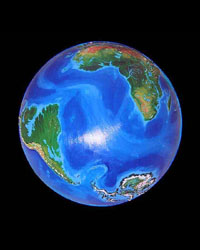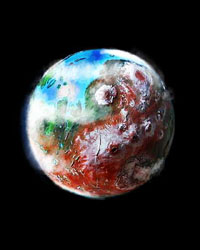World Dream Bank
home -
add a dream -
newest -
art gallery -
sampler -
dreams by
title,
subject,
author,
date,
places,
names
FUTURES!
1000 years. Three worlds. Same day.
by Chris Wayan, 2003-4
A series of tourist guides for the planets Earth, Venus and Mars
as they'll be one thousand years from now--three worlds transformed.
DUBIA
An Earth with doubled CO2,
flooded coasts, temperate poles
| MARS REBORN
Terraformed, but
definitely not Terra
| VENUS UNVEILED
the ugly duckling
becomes a swan

| 
| 
| |
THE RULES OF THE GAME
Imagine it's exactly one thousand years from now. Picture Earth, Mars, and Venus, all on the same day. How have the three worlds changed? Skip the usual human-centered concerns of science fiction--cultures, technology, cities...utopia or extinction. Focus beyond us and our big egos for once! What of the background behind the human drama? The geography and ecology of these three worlds, as worlds?
Now go find some globes in a thrift store. Buy them, steal them, I don't care. But take them apart and rebuild them--as globes of the future. And while you research and sculpt the complex landforms of these three worlds, contemplate the following questions:
- What's this world's orbit? Could our descendants have changed it? Even if they could, would they? Would the risks be unacceptable?
- How big is this world? What's its gravity? Low gravity means it's harder to retain atmosphere, but it also means air thins more slowly with altitude--and Mars for one has verticality to spare!
- How hot is this planet, anyway? Don't obsess on CO2, it's only one factor. How much sun does this world get? And don't forget the effect of sheer thickness of an atmosphere. And the effects of albedo--a white cloud-cover, or ice, or a pale dusty desert, don't absorb as much as deep blue sea, or green jungles. Oh, and the fifth factor--human meddling. Orbiting parasols, fluorescent gas-clouds of neon, swarms of mirror-moons... Looking at our world, you'd think the primal human drives are food, sex and TV. Nope. The real goal of humanity is thermostatic comfort: cold beer, warm feet, and air conditioning. Godlike humans can indulge this taste on a planetary scale...
- Does this world spin? How fast? How long are day and night--or have these been abolished with smoke and mirrors? What's the spin do to heat distribution--dayside versus nightside, tropics versus poles?
- What's its axial tilt? That affects how strong the seasons are. And is it stable? Venus is nearly tiltless now, while Mars is thought to slowly shift back and forth from an Earthlike tilt to an extreme 50-60 degrees. Could terraformers on Venus induce eccentricity, to cause seasons, or induce spin at an angle, so the new poles are skewed? Even if they can... should they?
- How wet is this planet? If terraforming's been done, has the water content changed? Are there oceans? If so, is there land around the poles, encouraging big ice caps, or will there just be sea ice, which doesn't heap up?
- What do those big or small icecaps do to sea levels? Where will your new coastlines be, and what does that do to your continents? New lands may emerge, or old ones may break up, or have inland seas.
- Is your climate stable? Might it fluctuate or even cycle regularly?
- Think globally, sculpt locally! Which parts of your new tilted, shrunken, flooded or emergent lands are hot, cold, temperate, fluctuating?
- Latitude doesn't totally determine warmth. Where are the major currents? What coasts do they heat or cool? How high is the land, does that modify the climate?
- Where do the winds come from? Where will rain fall, where will you get deserts? On Earth now, the weak dry winds around 20-35 degrees north and south, or any wind from deep inland, can mean trouble. But on your worlds, are there three Hadley cells (heat-convection loops) as on Earth today? Or are tropics, temperate zones, and cold poles strictly a local thing? Hadley cells are also affected by spin. Fast-spinning Jupiter has many bands, while stodgy Venus has a simpler atmosphere (just one big cell?). But 1000 years from now, is that still true--or has someone spun Venus?
- Where do mountains harvest water from sea-winds, and where do they create rainshadows?
- Will your continental interiors heat up in summer enough to create updrafts, driving monsoon winds?
- What sort of creatures evolve to fit your new ecology? Or... is evolution obsolete? Are people and creatures aggressivley bioengineered to fit the new niches? If so, from what species? If nonhuman species are the templates for people on your new worlds, how are they different from the ape-based folks we know? And how do different species interact?
- All this assumes artificial intelligence hasn't totally replaced biology. Even if all intelligence is now chip-based, are there hybrids, do AIs find that having a body is a useful thing? Or if not useful, entertaining... or if not entertaining, at least character-building! Let's say so, for the sake of the game--let's assert that individual (if not necessarily human) people still exist, and care enough about the land to maintain a viable ecological pattern rather than abandoning planets or turning them into giant webservers. But what pattern?
Rough in your new world, land by land. Expect a lot of corrections--climate, like evolution, is feedback-chaos!
Now paint your globe in detail. Deep green jungles, olive savannas and scrublands, yellowish grasslands, green temperate forests, pine-dark subarctic forests, brown and reddish deserts, pale sand dunes, black lava fields, white ice, turquoise reefs and shallows, indigo abysses...
THE GOAL
Now step back and evaluate. Overall, what have you got? Have you gained or lost, in a thousand years?
You can try to maximize biomass, or biodiversity, or the most habitable land; or simply try to minimize dead or marginal lands; or even try to create the most places with conditions likely to evolve intelligent creatures spontaneously--sapiogenesis, to coin a word.
Or you can simply aim for the strangest worlds.
Remember, though, you're not God. The game is FUTURES, not CONTINENTAL DRIFT or RANDOM WORLDBUILDING (not that those aren't fun too). You're stuck with the landforms we know. Yes, people 1000 years from now who can terraform worlds could surely move mountains or even continents if they wanted to, but part of the fun is to map bizarre changes onto familiar landforms! So hands off world geography--no adding new continents, no moving them around. The Pacific and Hellas are deep basins, and they will be in 1000 years, too. Tibet, Tharsis and Ishtar will still be highlands. Use existing geography!
The rest, you extrapolate. Because nothing teaches climatology faster than having to create a climate.
Oh--one final question. Do you like the world you made?
Now go outside. Look around. And repeat the question.
Three related sets of world-models: Tilt! -- The Biosphere Variations -- Caprices -- Home page for all four sets: Planetocopia
LISTS AND LINKS: terraforming - other worlds - ecology - time travel - climate change - evolution - orbital dreams - populations and eco-crashes - natural disasters - sculptures and 3D art -
World Dream Bank homepage - Art gallery - New stuff - Introductory sampler, best dreams, best art - On dreamwork - Books
Indexes: Subject - Author - Date - Names - Places - Art media/styles
Titles: A - B - C - D - E - F - G - H - IJ - KL - M - NO - PQ - R - Sa-Sk - Sl-Sz - T - UV - WXYZ
Email: wdreamb@yahoo.com - Catalog of art, books, CDs - Behind the Curtain: FAQs, bio, site map - Kindred sites